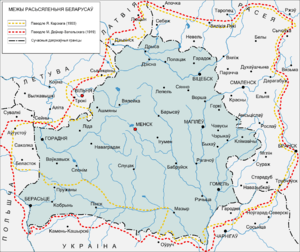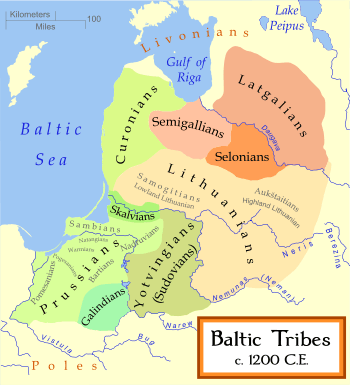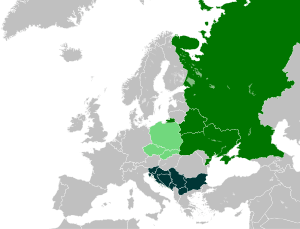Belarusians
| Total population | |
|---|---|
| c. 9.5–10 million | |
| Regions with significant populations | |
|
| |
(Belarusian ancestry) | 600,000[3][4]–768,000[5] |
| 521,443 (2010)[6] | |
| 275,763 (2001)[7] | |
| 68,174 (2011)[8] | |
| 66,476 (2010)[9] | |
| 47,000 (2011)[10] | |
| 41,100[11] | |
| 20,000[12] | |
| 15,565[13] | |
| 12,171 (2016)[14] | |
| 7,500[12] | |
| 7,000[12] | |
| 7,000[12] | |
| 7,000[12] | |
| 2,833[15] | |
| 2,000[12] | |
| 1,560 (2006)[16] | |
| 1,168[17] | |
| 1,002 (2009)[18] | |
| Languages | |
|
Belarusian Russian | |
| Religion | |
| Orthodox Christianity (majority), Roman Catholicism (minority) | |
| Related ethnic groups | |
| Other East Slavs | |
Belarusians (Belarusian: беларусы, bielarusy; Russian: белорусы), or Byelorussians, are an East Slavic ethnic group who are native to modern-day Belarus and the immediate region. There are over 9.5 million people who proclaim Belarusian ethnicity worldwide, with overwhelming majority residing either in Belarus or the adjacent countries where they are an autochthonous minority.
Location

Belarusians are an East Slavic ethnic group who populate the majority of the Republic of Belarus. Belarusian minority populations live in countries neighboring Belarus: in Ukraine, in Poland (especially in the Podlaskie Voivodeship), in the Russian Federation and in Lithuania. At the beginning of the 20th century Belarusians constituted a minority in the regions around the city of Smolensk in Russia.
Significant numbers of Belarusians emigrated to the United States, Brazil and Canada in the early 20th century. During Soviet times (1917–1991), many Belarusians were deported or migrated to various regions of the USSR, including Siberia, Kazakhstan and Ukraine.
Since the breakup of the USSR in 1991 several hundred thousand have emigrated to the Baltic states, the United States, Canada, Russia, and EU countries.
Languages
The two official languages in Belarus are Belarusian and Russian. Russian is the most spoken language, principally by 72% of the population, while Belarusian is only used by 11.9%[19] in everyday life. According to a study, in varying degrees, the vast majority of residents speak the Belarusian language: 29.4% are fluent, being able read and write it, 52.5% can speak and read the language, 8.3% can understand it but can't speak or read it, while a further 7% are able to understand the parts of Belarusian language that are similar to Russian.[19] Belarusian is a language of the East Slavic group.
The name Belarus can be literally translated as White Ruthenia that is a historical region in the east of modern Republic of Belarus, known in Latin as Ruthenia Alba (English: White Rus). This name was in use in the West for some time in history, together with White Ruthenes, White Russians (though not to be confused with the political group of White Russians that opposed the Bolsheviks during the Russian Civil War) and similar forms. Belarusians trace their name back to the people of Rus'.
The term Belarusians was promoted mostly during the 19th century by the Russian Empire. For instance, this can be traced by editions of folklorist researches by Ivan Sakharov, where in the edition of 1836 Belarusian customs are described as Litvin, while in the edition of 1886 the words Литва (Lithuania) and Литовцо-руссы (Lithuanian-Russians/Ruthenians) are replaced by respectively Белоруссия (Byelorussia) and белоруссы (Byelorussians).[20][21][22]
_compared_with_today's_borders_(ENG).png)
Legend:
History

The Belarusian people trace their distinct culture to the Grand Duchy of Lithuania, earlier Kievan Rus and the Principality of Polatsk. Most Belarusians are descendants of the East Slav tribes Dregovichs, Krivichs and Radimichs, as well as of a Baltic tribe of Jotvingians who lived in the west and north-west of today's Belarus.[23]
Belarusians began to emerge as a people during the thirteenth through fourteenth centuries in the Grand Duchy of Lithuania. Mostly on the lands of the upper basins of Neman River, Dnieper River and the Western Dvina River.[24]
In 13th–18th centuries Belarusians were mostly known under the names of Litvins/Lithuanians and Ruthenians which refers to the Eastern part of state of the Grand Duchy of Lithuania (Litva, Vialikaja Litva) of which the White Ruthenian, Black Ruthenian and Polesian lands were part of since the 13th–14th centuries, and where the Ruthenian language developed and gradually became the dominant written language in the Grand Duchy of Lithuania, replacing Latin. Casimir's Code of 1468 and all three editions of Statutes of the Grand Duchy of Lithuania (1529, 1566, and 1588) were written in the Ruthenian (also referred to as Old Belarusian) language. From the 1630s it was replaced by Polish, as a result of Polish high culture acquiring increasing prestige in the Polish-Lithuanian Commonwealth.
On the grounds of the dominance of Ruthenian language (which later evolved into contemporary Belarusian and Ukrainian Languages) and culture in the Eastern parts of the Grand Duchy of Lithuania, some "modern" Belarusian scholars and people in Belarus consider the Grand Duchy of Lithuania to be a Belarusian state when it existed.[25][26][27]
Between 1791 and 1917 much of Belarus, with its Christian and Jewish populations, was acquired by the Russian Empire in a series of military conquests and diplomatic manoeuvres, and was made part of a region known as the Pale of Settlement.
After World War I Belarusians revived their own statehood, with varying degrees of independence – first as the short-lived Belarusian National Republic under German occupation, then as the Byelorussian SSR from 1919 until 1991, which merged with other republics to become a constituent member of the Soviet Union in 1922). Belarus gained full independence with the dissolution of the Soviet Union in 1991.
Cuisine
Belarusian cuisine shares the same roots with cuisines of other Eastern and Northern European countries, basing predominantly on meat and various vegetables typical for the region.
See also
- List of Belarusians (ethnic group)
- Demographics of Belarus
- Dregovichs
- Krivichs
- Litvins
- Radimichs
- History of Belarus
Notes
- ↑ "Changes in the populations of the majority ethnic groups". belstat.gov.by. Archived from the original on 28 July 2016. Retrieved 2016-07-28.
- ↑ "Demographic situation in 2015". Belarus Statistical Office. 27 January 2016. Archived from the original on 3 February 2016. Retrieved 27 January 2016.
- ↑ Garnett, Sherman W. (1999). Belarus at the Crossroads. Washington, D.C.: Carnegie Endowment for International Peace. ISBN 978-0-87-003172-4.
- ↑ Kipel, Vituat. "Belarusan americans". World Culture Encyclopedia. Retrieved July 28, 2016.
- ↑ "Country: United States: Belarusians". Joshua Project. 2016. Retrieved 23 May 2016.
- ↑ "All-Russian population census 2010 population by nationality, sex and subjects of the Russian Federation". Demoscope Weekly (in Russian). Retrieved July 28, 2016.
- ↑ Про кількість та склад населення України за підсумками Всеукраїнського перепису населення 2001 року (Ukrainian)
- ↑ "On key provisional results of Population and Housing Census 2011". Retrieved 18 March 2015.
- ↑ "Перепись населения Республики Казахстан 2009 года. Краткие итоги. (Census for the Republic of Kazakhstan 2009. Short Summary)" (PDF) (in Russian). Republic of Kazakhstan Statistical Agency. Archived from the original (PDF) on 12 December 2010. Retrieved 10 December 2010.
- ↑ Przynależność narodowo-etniczna ludności – wyniki spisu ludności i mieszkań 2011. GUS. Materiał na konferencję prasową w dniu 29. 01. 2013. p. 3. Retrieved 2013-03-06.
- ↑
- 1 2 3 4 5 6 "Как живешь, белорусская диаспора?". Belarus Time (in Belarusian). March 13, 2012. Archived from the original on March 13, 2012.
- ↑ "Ethnic Origin (264), Single and Multiple Ethnic Origin Responses (3), Generation Status (4), Age Groups (10) and Sex (3) for the Population in Private Households of Canada, Provinces, Territories, Census Metropolitan Areas and Census Agglomerations, 2011 National Household Survey".
- ↑ 2016 census. Eesti Statistikaamet.
- ↑ "Utrikes födda efter födelseland och invandringsår" [Foreign-born by country of birth and year of immigration] (XLS). Statistics Sweden (in Swedish). 31 December 2015. Retrieved 23 October 2016.
- ↑ "20680-Ancestry (full classification list) by Sex - Australia". 2006 Census. Australian Bureau of Statistics. Archived from the original (Microsoft Excel download) on March 10, 2008. Retrieved 2008-06-02.
- ↑ "Error" (PDF). Retrieved 18 March 2015.
- ↑ "POPULAÇÃO ESTRANGEIRA RESIDENTE EM TERRITÓRIO NACIONAL - 2009" (PDF). Statistics Portugal (in Portuguese). January 1, 2011. Retrieved July 28, 2016.
- 1 2 "Общество". Retrieved 18 March 2015.
- ↑ Сказанія русскаго народа, собранныя Иваномъ Петровичемъ Сахаровымъ, 1836, 1886
- ↑ Бандарчык В. К. Фарміраванне і развіццё беларускай нацыі / В. К. Бандарчык, П. У Церашковіч // Этнаграфія беларусаў.— Мінск : Навука і тэхніка, 1985.— С. 158.
- ↑ Беларусы : у 10 т. / Рэдкал.: В. К. Бандарчык [і інш.]. — Мінск : Беларус. навука, 1994–2007. — Т. 4 : Вытокі і этнічнае развіццё... С. 62—63, 88.
- ↑ http://www.krugosvet.ru/enc/istoriya/BELORUSI.html Энциклопедия Кругосвет
- ↑ Беларусы : у 10 т. / Рэдкал.: В. К. Бандарчык [і інш.]. — Мінск : Беларус. навука, 1994–2007. — Т. 4 : Вытокі і этнічнае развіццё... С. 36, 49.
- ↑ Renshaw, Cheryl (5 June 2002). "The Grand Duchy of Lithuania 1253-1795". University of Washington, Baltic Studies. Archived from the original on 19 January 2012.
- ↑ Ivan Saverchanka "portrays the Grand Duchy of Lithuania as a strong Belarusian state in the center of Europe". Zejmis, Jakub, "Belarusian National Historiography and the Grand Duchy of Lithuania as a Belarusian State," Zeitschrift für Ostmitteleuropa-Forschung , 1999, 48, pp. 392–383.
- ↑ Elena Gapova. "The Nation in Between". Over the Wall/After the Fall: Post-Communist Cultures Through an East-West Gaze. Indiana University Press. 2004. p. 65.
References
- Арсеньев, К. Статистические очерки России / К. Арсеньев. — Санкт-Петербург : Тип. Импер. академии наук, 1848. — 503 с.
- Беларусы : у 10 т. / Рэдкал.: В. К. Бандарчык [і інш.]; Інстытут мастацтвазнаўства, этнаграфіі і фальклору імя Кандрата Крапівы НАН Беларусі. — Мінск : Беларус. навука, 1994–2007. — Т. 3 : Гісторыя этналагічнага вывучэння / В. К. Бандарчык [і інш]. — 2001. — 433 с.
- Беларусы : у 10 т. / Рэдкал.: В. К. Бандарчык [і інш.]; Інстытут мастацтвазнаўства, этнаграфіі і фальклору імя Кандрата Крапівы НАН Беларусі. — Мінск : Беларус. навука, 1994–2007. — Т. 4 : Вытокі і этнічнае развіццё / В. К. Бандарчык [і інш]. — 2001. — 433 с.
- Беларусы : у 10 т. / Рэдкал.: В. К. Бандарчык [і інш.]; Інстытут мастацтвазнаўства, этнаграфіі і фальклору імя Кандрата Крапівы НАН Беларусі. — Мінск : Беларус. навука, 1994–2007. — Т. 6 : Грамадскія традыцыі / В. К. Бандарчык [і інш]. — 2002. — 606 с.
- Белоруссия // Географическо-статистический словарь Российской империи / сост. П. Семенов; Русское географическое общество. — СПб : Тип. В. Безобразова, 1863. — Т. I. — С. 371.
- Белоруссия // Энциклопедический словарь; изд. Ф.А. Брокгауз, И.А. Эфрон. — СПб : Тип. И.А. Эфрона, 1891. — Т. V. — С.231.
- Белоруссы // Энциклопедический словарь; изд. Ф.А. Брокгауз, И.А. Эфрон. — СПб : Тип. И.А. Эфрона, 1891. — Т. V. — С. 232—234.
- Белорусы // Большая Российская энциклопедия: в 30 т. / Председатель Науч.-ред совета Ю.С. Осипов. Отв. ред. С.Л. Кравец. — Москва : Большая Российская энциклопедия, 2005. — Т. 3. «Банкетная кампания» 1904 — Большой Иргиз. — С . 260—262.
- Белы, А. Белая Русь / А. Белы // Вялікае княства Літоўскае : энцыкл. : у 2 т. — Мінск , 2006. — Т. 1. — С. 306—308.
- Белы, А. Хроніка «Белай Русі»: нарыс гісторыі адной геаграфічнай назвы / А. Белы. — Мінск : Энцыклапедыкс, 2000. — 238 с. — ISBN 985-6599-12-1
- Бандарчык, В.К. Гісторыя беларускай этнаграфіі XIX ст. / В.К. Бандарчык. — Мінск : Навука і тэхніка, 1964. — 282 с.
- Гісторыя Беларусі: Падруч. у 2 ч. / Я.К. Новік, Г.С. Марцуль, І.Л. Качалаў і інш.; Пад рэд. Я.К. Новіка, Г.С. Марцуля. — Мн.: Выш. шк., 2003. — Ч. 1. Ад старажытных часоў — па люты 1917 г. — 416 с.
- Гісторыя Беларусі: у 6 т. / Ю. Бохан [і інш.]; рэдкал: М. Касцюк (гал. рэд.) [і інш.]. — Т. 2. Беларусь у перыяд Вялікага Княства Літоўскага. — Мінск : Экаперспектыва, 2008. — 688 с.
- Гісторыя беларускай дзяржаўнасці ў канцы XVIII ст. — пачатку XXI ст.: у 2-х кн. / А.А. Каваленя [і інш.] ; Нац. акад. навук Беларусі, Ін-т гісторыі. — Мінск : Беларуская навука, 2011. — Кн. 1. — 584 с.
- Гринблат, М.Я. Белорусы. Очерки происхождения и этнической истории / М.Я. Гринблат. — Минск : Наука и техника, 1968. — 288 с.
- Дзярновіч, А. Пошукі Айчыны: «Літва» і «Русь» у сучаснай беларускай гістарыяграфіі / А. Дзярновіч // Палітычная сфера. — 2012. — №18—19(1—2). — С. 30—53.
- Долбилов, М.Д. Русский край, чужая вера: Этноконфессиональная политика империи в Литве и Белоруссии при Александре II / М.Д. Долбилов. — М. : Новое литературное обозрение, 2010. — 1000 с.
- Живописная Россия: Отечество наше в его земельном, историческом, племенном, экономическом и бытовом значении: Литовское и Белоруское Полесье / под общ. ред. П.П. Семенова. — репринт. воспр. изд. 1882 г. — Минск : БелЭн, 1993. — 550 с.
- Зайкоўскі, Э.М. Этнічная i канфесійная сітуацыя ў гістарычнай Літве на рубяжы XIV—XV стст. / Э.М. Зайкоўскі // Вялікае княства Літоўскае і яго суседзі ў XIV—XV стст.: саперніцтва, супрацоўніцтва, урокі: Да 600-годдзя Грунвальдскай бітвы: матэрыялы Міжнароднай навуковай канферэнцыі (Гродна, 8–9 ліп. 2010 г.) / НАН Беларусі, Ін-т гісторыі; Гродзенскі дзярж. ун-т імя Янкі Купалы. — Мн.: Беларуская навука, 2011. — С. 11—25.
- Корнилов, И. Русское дело в Северо-Западном крае. Материалы для истории Виленского учебного округа преимущественнно в муравьевскую эпоху / И. Корнилов. — Санкт-Петербург : Тип. А. Лопухина, 1901. — 420 с.
- Литовское племя // Географическо-статистический словарь Российской империи / сост. П. Семенов; Русское географическое общество. — СПб : Тип. В. Безобразова, 1867. — Т. III. — С. 62—64.
- Марзалюк, І. Людзі даўняй Беларусі: этнаканфесійныя і сацыякультурныя стэрэатыпы (Х—XVII ст.). — Магілёў, 2003.
- Марзалюк, І.А. Міфы «адраджэнскай» гістарыяграфіі Беларусі: манаграфія / І.А. Марзалюк. — Магілёў : МДУ імя А.А. Куляшова, 2009. — 148 с.
- Марзалюк, І. Тэрміналогія этнічнай гісторыі Беларусі 14–17 ст.: набліжэнне да рэаліяў, ці стварэнне новых міфаў? / І. Марзалюк // Гістарычны альманах. — 2003. — Т. 9. — С. 113—122.
- Народы России. Белорусы и поляки / Издание "Досуг и дело". — СПб : Общественная польза, 1878. — 68 с.
- Насытка, Я. «Тыя ж беларусы…»: Этнічныя межы беларусаў у XIX — пачатку XX ст. / Я. Насытка // Беларуская мінуўшчына. — 1994. — № 4. — С. 11—15.
- Петров, Н.И. Белоруссия и Литва. Исторические судьбы Северо-Западного края / Н.И. Петров. — СПб. : Тип. Тов. "Общественная польза", 1890. — 585 с.
- Реклю, Э. Россия европейская и азиатская : в 2 т. / Э. Реклю. — Т. 1. Европейская Россия. До Урала. — СПб. : А. Ильин, 1883. — 700 с.
- Сагановіч, Г. Нарыс гісторыі Беларусі ад старажытнасці да канца XVIII стагоддзя / Г. Сагановіч. — Мінск : Энцыклапедыкс, 2001. — 412 с.
- Самбук, С.М. Политика царизма в Белоруссии во второй половине XIX века / Ред. В.П. Панютич. — Минск : Наука и техника, 1980. — 224 с.
- Сементовский, А. Этнографический обзор Витебской губернии / А. Сементовский. — Санкт-Петербург : Тип. Н. Хана. — 1872. — 69 с.
- Сталюнас, Д. Границы в пограничье: белорусы и этнолингвистическая политка Российской империи на Западных окраинах в период Великих Реформ / Д. Сталюнас // Ab Imperio. 2003 — № 1. — С. 261—292.
- Столпянский, Н.П. Девять губерний Западно-Русского края в топографическом, геогностическом, статистическом, экономическом, этнографическом и историческом отношениях : (С карт. девяти губерний края) / Н.П. Столпянский. — СПб : тип. Гогенфельдена и К°, 1866. — 200 с.
- Смалянчук, А. Дыскусія пра вытокі на фоне «ідэалягічнай рэвалюцыі» / А. Смалянчук // ARCHE. — 2008. — №3. — С. 53—57.
- Смалянчук, А.Ф. Паміж краёвасцю і нацыянальнай ідэяй. Польскі рух на беларускіх і літоўскіх землях. 1864 — люты 1917 г. / А. Ф. Смалянчук. — СПб. : Неўскі прасцяг, 2004. — 406 с.
- Тегако, Л.И. Антропология белорусского Полесья: демография, этническая история, генетика / Л.И. Тегако, А.И. Микулич, И.И. Саливон. — Минск. — 1978.
- Терешкович, П.В. Этническая история Беларуси XIX — начала XX в.: В контексте Центрально-Восточной Европы / П.В. Терешкович. — Минск : БГУ, 2004. — 233 с.
- Титов В. С. Историко-этнографическое районирование материальной культуры белорусов. ― Мн., 1983.
- Флоря, Б.Н. О некоторых особенностях развития этнического самосознания восточных славян в эпоху Средневековья — раннего Нового времени // Материалы конференции «Россия-Украина: история взаимоотношений». — Москва, 1997. — C. 9—27.
- Чаквин, И.В. Из истории становления национального самосознания белорусов (XIV — начало XX вв.) / И.В. Чаквин, П.В. Терешкович // Советск. этнография. — 1990. — № 6. — С. 42—54.
- Чаквін, І. Нацыя ліцвінаў у этнагенезе беларусаў: Параўнальна-тыпалагічны і гістарычны аспекты / І. Чаквін // Беларусіка = Albaruthenica. Кн. 6 : Беларусь паміж Усходам і Захадам: Праблемы міжнац., міжрэліг. і міжкультур. узаемадзеяння, дыялогу і сінтэзу. — Мінск : ННАЦ імя Ф. Скарыны, 1997. — Ч. 1. — С. 37—42.
- Ширяев, Е.Е. Беларусь: Русь Белая, Русь Черная и Литва в картах / Е.Е. Ширяев. — Минск : Навука і тэхніка, 1991. — 119 с.
- Шыбека, З. Нарыс гісторыі Беларусі (1795—2002) / З. Шыбека. — Мінск : Энцыклапедыкс, 2003. — 490 с.
- Эркерт, Р.Ф. Взгляд на историю и этнографию западных губерний России : (с атласом) / [соч.] Полк. Р.Ф. Эркерта. — Санкт-Петербург : тип. Дома призрения малолет. бедных, 1864. — 72 с.
- Этнаграфія беларусаў: гістарыяграфія, этнагенез, этнічная гісторыя / В. К. Бандарчык [і інш]. — Мінск : Навука і тэхніка, 1985. — 215 с.
- Этнаграфія Беларусі : энцыклапедыя / рэдкал. І.П. Шамякін [і інш.]. — Мінск : БелСЭ, 1989. — 575 с.
- Lithuanians and letts // The Encyclopædia Britannica : a dictionary of arts, sciences, literature and general information. — Cambridge : University press, 1911. — Volime XVI. — P. 789—791.
External links
- Ethnographic Map (New York, 1953)
- CIA World Fact Book 2005
- "ЧТО ТАКОЕ БЫТЬ БЕЛОРУСОМ?" ("What does it mean to be a Belarusian? ") a 2009 survey (Russian) at the Wayback Machine (archived 20121120095257)
.svg.png)
